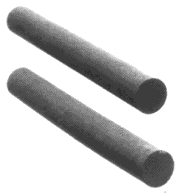FERRITE RODS, BARS, PLATES AND TUBES
|
Ferrite rods, bars, plates and tubes are primarily used in radio antennas and chokes. They are available in materials from permeability of 20 to 10, 000. Only rods with #61 (ui - 125), and #33 (ui = 800) materials are standard stocking items. All other materials are custom manufactured, readily available with lead time for delivery.
Standard Stocking Rods
Other dimensions and materials are available. Please call for your other requirements. FERRITE RODS are available as standard stocking items in various sizes in the #33 and #61 materials. Ferrite rods of other materials are available with lead time. The most common use of a ferrite rod is for antenna and choke applications. ANTENNAS: Ferrite Rods are widely used as loop antennas for such as broadcast-band receivers, direction-finder receivers, etc.The #61 material rods are widely used for commercial AM (550 KHz to 1660 KHz) radio antennas and by radio amateurs (2 MHz to 30 MHz). The #33 material rods are more suitable for very low frequency ranges (100 KHz to 1 MHz). The table below lists the recommended frequency ranges for a few different materials. Loop antennas have a height factor called effective height, he (in m), which when multiplied with field strength, F (in uV/m), provides the loop-induced voltage (in uV).
It can be seen from the equation that the highest induced voltage occurs when the windings occupied the entire rod (when N is largest).
*Frequency ratings are for optimum Q in narrow-band tuned circuits. CHOKE applications: Both the #33, and the #61 rods are used extensively in choke applications. The #33 material should be selected for the 3.75 - 7.5 MHz (40-80 meters band). The #33 rods are also often used in speaker cross-over networks. The #61 material is most suitable for the 7.5-30 MHz (10-40 meters band) range. Due to the open magnetic structure of the rod configuration, considerable current can be tolerated before it will saturate. There are several factors that have a direct bearing on the effective permeability of a ferrite rod, which in turn will effect inductance and 'Q', as well as the AL value of the rod and its ampere-turns rating. These are: (1) Length to diameter ratio of the rod, (2) Placement of the coil on the rod, (3) Spacing between turns and, (4) Air space between the coil and the rod. In some cases, the effective permeability of the rod will be influenced more by a change in the length to diameter ration than by a change in the initial permeability of the rod. At other times, just the reverse will be true. Greatest inductance and AL value will be obtained when the winding is centered on the rod rather than placed at either end. The best 'Q' will be obtained with the winding covers the entire length of the rod. Because of all of the above various conditions it is very difficult to provide workable AL values. However we have attempted to provide a set of AL and NI values for various types of rods in our stick. These figures are based on a closely wound coil of #22 wire, placed in the center of the rod and covering nearly the entire length. Keep in mind that there are many variables and that the inductance will vary according to winding technique. EFFECTIVE PERMEABILITY
EFFECTS ON 'Q' Except for those rods (#61 & #33) listed above, the following plates, rods, tubes and strips are non-stocking items. Non-stocking items are custom manufactured parts with lead times. Please call for information on pricing and delivery. Those stocking item rods can be shipped out immediately. The materials available are: #68 (ui = 20), #67 (ui = 40), #61 (ui = 125, #33 (ui = 800), #77 (ui = 2000), #73 (ui = 2500), #F (ui = 3000), #J (ui = 5000), and #W (ui = 10, 000). The rods, tubes and strips can be manufactured in lengths up to a maximum of 12 inches. The dimensional tolerances for rods, tubes, and strips are approximately +/- 6%, and for plates are +/- 2%. All length tolerances are +/- 2%. The camber tolerance is 0.11 per inch. (dimensional graphics and tables)
|
||||||||||||||||||||||||||||||||||||||||||||||||||||||||||||||||||||||||||||||||||||||||||||||||||||||||||||||||||||||||||||||||||||||||||||||||||||||||||||||||||||||||||||||||||||||||||||||||||||||||||||||||||||||||||||||||||||||||||||||||||||||||||||||||||||||||||||||||||||||||||||||||||||||||||||||||||||||||||||||||||||
353 West Grove Avenue, Orange, CA 92865, U.S.A.
800-679-3184
© 1996 - 2002 CWS ByteMark
All Rights Reserved







